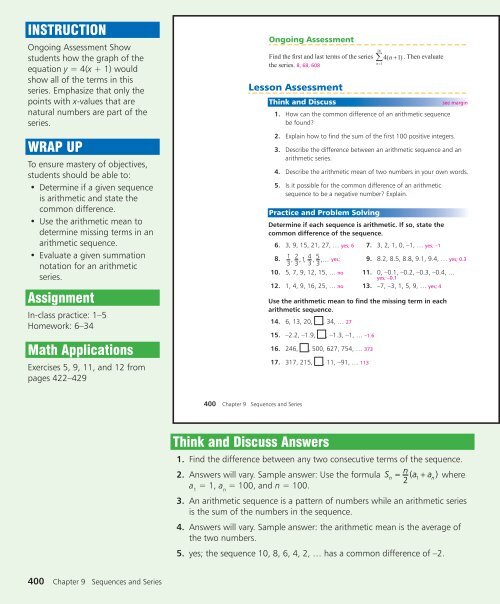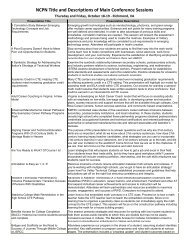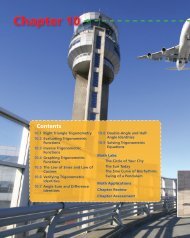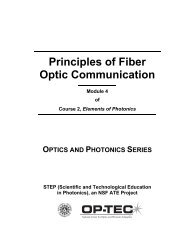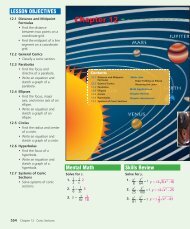hvvrq $ulwkphwlf 6htxhqfhv dqg 6hulhv - NCPN
hvvrq $ulwkphwlf 6htxhqfhv dqg 6hulhv - NCPN
hvvrq $ulwkphwlf 6htxhqfhv dqg 6hulhv - NCPN
You also want an ePaper? Increase the reach of your titles
YUMPU automatically turns print PDFs into web optimized ePapers that Google loves.
INSTRUCTION<br />
Ongoing Assessment Show<br />
students how the graph of the<br />
equation y = 4(x + 1) would<br />
show all of the terms in this<br />
series. Emphasize that only the<br />
points with x-values that are<br />
natural numbers are part of the<br />
series.<br />
WRAP UP<br />
To ensure mastery of objectives,<br />
students should be able to:<br />
• Determine if a given sequence<br />
is arithmetic and state the<br />
common difference.<br />
• Use the arithmetic mean to<br />
determine missing terms in an<br />
arithmetic sequence.<br />
• Evaluate a given summation<br />
notation for an arithmetic<br />
series.<br />
Assignment<br />
In-class practice: 1–5<br />
Homework: 6–34<br />
Math Applications<br />
Exercises 5, 9, 11, and 12 from<br />
pages 422–429<br />
<br />
<br />
<br />
<br />
<br />
<br />
4( + 1)<br />
<br />
=<br />
1<br />
<br />
<br />
<br />
<br />
<br />
<br />
<br />
<br />
<br />
<br />
16<br />
∑<br />
<br />
<br />
<br />
<br />
<br />
1<br />
,<br />
2<br />
,<br />
3 3 1 , 4 ,<br />
5<br />
,… 1 <br />
3 3 3<br />
<br />
<br />
<br />
<br />
<br />
<br />
<br />
<br />
<br />
<br />
<br />
Think and Discuss Answers<br />
1. Find the difference between any two consecutive terms of the sequence.<br />
2. Answers will vary. Sample answer: Use the formula S<br />
n<br />
n<br />
= ( a + a<br />
n) where<br />
2<br />
a 1<br />
1<br />
= 1, a n<br />
= 100, and n = 100.<br />
3. An arithmetic sequence is a pattern of numbers while an arithmetic series<br />
is the sum of the numbers in the sequence.<br />
4. Answers will vary. Sample answer: the arithmetic mean is the average of<br />
the two numbers.<br />
5. yes; the sequence 10, 8, 6, 4, 2, … has a common difference of –2.<br />
400 Chapter 9 Sequences and Series


